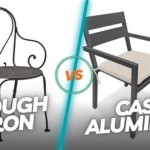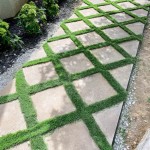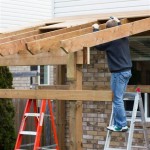How Much Does It Cost to Pour a Concrete Patio? A Comprehensive Guide
Concrete patios offer a durable and versatile outdoor living space, providing a solid foundation for various activities, from relaxing and entertaining to outdoor dining and grilling. However, before embarking on a concrete patio project, a clear understanding of the associated costs is crucial. Determining the final price involves considering several factors that influence the total expenditure, allowing homeowners to budget effectively and avoid unexpected financial burdens.
This article provides a comprehensive guide to estimating the cost of pouring a concrete patio, outlining the key elements that contribute to the overall expense. It delves into the price variations based on location, size, design complexity, labor costs, and site preparation needs. This information aims to equip homeowners with the knowledge necessary to make informed decisions and successfully manage their concrete patio projects.
Factors Influencing the Cost of a Concrete Patio
Several interconnected factors determine the final cost of a concrete patio. Understanding these elements is crucial for accurate budgeting and project planning. These factors can be broadly categorized into material costs, labor expenses, site preparation requirements, and design complexities.
Material Costs: The primary material cost is, of course, the concrete itself. Concrete prices fluctuate based on geographic location, aggregate type, and market demand. The cost is typically measured per cubic yard. Estimating the required volume of concrete involves calculating the patio's surface area (length x width) and desired thickness. A standard patio thickness is 4 inches, but thicker slabs may be necessary for heavy use or poor soil conditions. Beyond concrete, other essential materials include gravel base, reinforcing mesh or rebar, formwork lumber, and expansion joint material. The prices for these materials also vary depending on local suppliers and the specific requirements of the project.
Labor Costs: Labor is a significant portion of the overall cost. Hiring professional concrete contractors ensures proper mixing, pouring, leveling, and finishing of the concrete, resulting in a durable and aesthetically pleasing patio. Labor costs are typically calculated on an hourly rate or a per-square-foot basis. The complexity of the project, including intricate designs or difficult site access, can increase labor costs. Obtaining multiple quotes from reputable contractors is crucial to compare pricing and ensure fair market value.
Site Preparation: Proper site preparation is essential for a stable and long-lasting concrete patio. This typically involves removing existing vegetation, topsoil, and debris. The ground needs to be leveled and compacted to provide a solid base for the concrete slab. Depending on the existing ground conditions, additional work may be required, such as adding and compacting a gravel base for drainage and stability. Difficult site conditions, such as rocky soil or steep slopes, can increase site preparation costs.
Design Complexity: The complexity of the patio design significantly impacts the cost. Simple rectangular or square patios are typically the least expensive. Intricate designs, curves, or multiple levels require more time and skill, increasing labor costs. Decorative finishes, such as stamped concrete, colored concrete, or exposed aggregate, also add to the overall cost. These finishes require specialized techniques and materials.
Permits and Inspections: Some municipalities require permits for concrete patio installations. Obtaining the necessary permits involves application fees and may require submitting site plans. Inspections may also be required to ensure compliance with local building codes. These costs should be factored into the overall budget.
Estimating the Cost: A Step-by-Step Approach
Calculating the estimated cost of a concrete patio requires a systematic approach that considers all relevant factors. This involves accurately measuring the patio area, determining the required concrete volume, factoring in material costs, obtaining labor quotes, and accounting for site preparation and design considerations.
1. Calculate the Patio Area: Begin by measuring the length and width of the desired patio area. Multiply these dimensions to determine the total square footage. For example, a patio that is 10 feet long and 12 feet wide has a surface area of 120 square feet.
2. Determine Concrete Volume: Determine the desired concrete thickness. A standard thickness for patios is 4 inches, which is equivalent to 1/3 of a foot. Multiply the patio area by the concrete thickness to calculate the volume in cubic feet. In our example, 120 square feet multiplied by 1/3 foot equals 40 cubic feet. Convert cubic feet to cubic yards by dividing by 27 (since 1 cubic yard equals 27 cubic feet). Therefore, 40 cubic feet is approximately 1.48 cubic yards. It's advisable to order slightly more concrete than calculated to account for spillage and uneven ground conditions.
3. Calculate Material Costs: Obtain prices for concrete per cubic yard from local suppliers. Multiply the required cubic yards by the price per cubic yard to determine the concrete cost. Add the costs of other materials, such as gravel base, reinforcing mesh or rebar, formwork lumber, and expansion joint material. Factor in delivery charges for these materials.
4. Obtain Labor Quotes: Contact several reputable concrete contractors and request detailed quotes for the project. Ensure the quotes include all aspects of the work, such as site preparation, formwork, pouring, leveling, finishing, and cleanup. Compare the quotes carefully, considering not only the price but also the contractor's experience, reputation, and insurance coverage.
5. Estimate Site Preparation Costs: Assess the existing site conditions and estimate the costs associated with site preparation. This may involve removing vegetation, topsoil, and debris, leveling the ground, and compacting the soil. If a gravel base is required, factor in the cost of gravel and compaction services.
6. Account for Design Considerations: If the patio design includes intricate shapes, curves, or multiple levels, factor in the additional labor and material costs associated with these features. Decorative finishes, such as stamped concrete or colored concrete, will also increase the overall cost. Obtain specific quotes for these decorative elements from the contractor.
7. Factor in Permits and Inspections: Research local building codes and determine if permits are required for the concrete patio installation. Obtain information about permit fees and inspection requirements and include these costs in the budget.
Regional Cost Variations
The cost of pouring a concrete patio can vary significantly depending on geographic location. Factors such as labor rates, material availability, and local market conditions can influence the overall price. Areas with higher cost of living typically have higher labor rates, which can increase the cost of the project. Material costs may also vary depending on the availability of local aggregate sources and transportation costs.
Urban areas often have higher labor rates compared to rural areas. The demand for concrete services in urban centers can also drive up prices. Seasonal variations can also affect costs. Concrete prices may be higher during peak construction seasons due to increased demand. Weather conditions can also impact labor productivity and material costs. Areas with harsh winters may require additional precautions, such as using heated concrete or protecting the concrete from freezing, which can increase costs.
It is important to research local market conditions and obtain multiple quotes from contractors in the specific geographic area to gain an accurate understanding of the prevailing prices. Checking with local building supply stores can also provide insights into current material costs.
Cost-Saving Strategies
While pouring a concrete patio can be a significant investment, there are several strategies homeowners can employ to potentially reduce costs without compromising quality. Careful planning, material selection, and labor negotiations can lead to substantial savings.
Opt for a Simple Design: Intricate designs and decorative finishes significantly increase the cost of a concrete patio. Choosing a simple rectangular or square design can reduce labor costs and material expenses. Avoiding curves, multiple levels, and elaborate patterns can result in significant savings.
Consider a Smaller Patio: Reducing the size of the patio is a straightforward way to lower costs. Carefully assess the intended use of the patio and determine the minimum necessary size to accommodate the desired activities. Alternatively, consider a partial patio with other landscaping elements to reduce the concrete area.
Explore Alternative Materials: While concrete offers durability and longevity, alternative materials, such as pavers or gravel, may be more cost-effective for certain applications. Pavers, while requiring more installation labor, can be purchased in smaller quantities and may offer more design flexibility. Gravel patios are relatively inexpensive and easy to install, but they may require more maintenance.
Obtain Multiple Quotes: Obtain quotes from at least three to five reputable concrete contractors. Compare the quotes carefully, paying attention to the details of the work included, the materials used, and the contractor's experience and reputation. Do not solely focus on the lowest price; consider the overall value offered by each contractor.
Negotiate Labor Costs: Do not hesitate to negotiate labor costs with contractors. Be prepared to discuss the scope of the work, the timeline for completion, and any potential challenges that may arise. Inquire about potential discounts or incentives for completing the project during off-peak seasons.
Consider DIY Options (with Caution): For homeowners with experience in concrete work, a DIY approach may seem appealing. However, pouring concrete requires specialized knowledge and skills. Improper mixing, pouring, leveling, or finishing can result in a flawed patio that is prone to cracking or crumbling. If considering a DIY approach, thoroughly research the process, acquire the necessary tools and equipment, and be prepared to invest significant time and effort. It's often advisable to consult with a professional contractor before undertaking a DIY concrete patio project.
Prepare the Site Yourself (if possible): Preparing the site for concrete pouring can be a labor-intensive task, but it can also be a potential area for cost savings. Homeowners can remove vegetation, topsoil, and debris themselves, as well as level the ground and compact the soil. However, ensure to follow proper safety precautions and use appropriate equipment. If a gravel base is required, consider purchasing the gravel yourself and spreading it evenly across the site.
Long-Term Cost Considerations
While the initial cost of pouring a concrete patio is a primary concern, it is important to consider the long-term costs associated with maintenance and potential repairs. Concrete patios are generally durable and require minimal maintenance, but periodic cleaning and sealing can extend their lifespan and prevent damage.
Sealing the concrete patio every few years helps protect it from moisture, stains, and weathering. Sealants also enhance the appearance of the concrete and make it easier to clean. The cost of sealing a concrete patio is relatively low and can be easily done by homeowners. Regular cleaning with a mild detergent and water can remove dirt, debris, and stains. Avoid using harsh chemicals or abrasive cleaners that can damage the concrete surface.
Cracks can develop in concrete patios over time due to settlement, temperature fluctuations, or heavy loads. Small cracks can be repaired with concrete patching compounds. Larger cracks may require professional repair or replacement. Proper site preparation and the use of reinforcing mesh or rebar can help prevent cracks from forming.
In regions with freezing temperatures, concrete patios are susceptible to damage from freeze-thaw cycles. Water that penetrates the concrete can freeze and expand, causing cracks and surface scaling. Using air-entrained concrete and applying a concrete sealer can help prevent freeze-thaw damage.
By considering these long-term cost considerations and implementing proper maintenance practices, homeowners can ensure that their concrete patio remains a durable and aesthetically pleasing outdoor living space for many years to come.

Guide How Much Does A Concrete Patio Cost

How To Pour A Concrete Patio Learn About Pouring

Pouring Concrete Patio What Could Go Wrong With Doing It Yourself

Guide How Much Does A Concrete Patio Cost

Diy Concrete Patio In 8 Easy Steps How To Pour A Cement Slab

2024 Concrete Patio Cost Average To Pour A Angi

Guide How Much Does Stamped Concrete Cost

How Much Does A 30x30 Concrete Slab Cost Important Factors

Diy Concrete Patio How To Pour A Slab Bob Vila

Quikrete Building A Concrete Patio








